Insights from East Cary Family Physicians
In this blog, we’re diving into one of the most prevalent health conditions worldwide: diabetes. With millions of individuals affected by this metabolic disorder, it’s crucial to understand its causes, symptoms, management, and prevention strategies. Whether you’re newly diagnosed, caring for someone with diabetes, or seeking to enhance your knowledge, this guide aims to provide valuable insights and practical tips.
What is Diabetes?
Diabetes is a chronic health condition characterized by high levels of sugar (glucose) in the blood. This occurs due to either insufficient production of insulin (a hormone that regulates blood sugar) by the pancreas or the body’s inability to effectively use insulin. There are primarily three types of diabetes:
1.) Type 1 Diabetes: Typically diagnosed in childhood or adolescence, type 1 diabetes occurs when the immune system attacks and destroys insulin-producing cells in the pancreas. Individuals with type 1 diabetes require lifelong insulin therapy.
2.) Type 2 Diabetes: This prevalent form of diabetes arises from insulin resistance or insufficient insulin production. Lifestyle factors like poor diet, sedentary habits, and genetic predispositions contribute significantly to its development. Type 2 diabetes is increasingly prevalent among younger populations, underscoring the urgency for preventive measures.
3.) Gestational Diabetes: Occurring during pregnancy, gestational diabetes results from hormonal shifts impairing insulin function. While it typically resolves postpartum, it raises the risk of type 2 diabetes in affected individuals later in life.
Symptoms of Diabetes:
The symptoms of diabetes can vary depending on its type and severity. Common signs and symptoms include:
• Polyuria (excessive urination)
• Polydipsia (excessive thirst)
• Unexplained weight loss (common in type 1 diabetes)
• Fatigue
• Blurred vision
• Delayed wound healing
• Peripheral neuropathy (tingling or numbness in extremities)
It’s important to note that some individuals with type 2 diabetes may not experience noticeable symptoms initially, which is why regular health check-ups and screenings are essential for early detection and management.
Managing Diabetes:
While diabetes is a serious condition, effective management can help individuals lead healthy, fulfilling lives. Here are key components of diabetes management:
• Blood Sugar Monitoring: Regular monitoring of blood sugar levels using a glucose meter helps individuals understand how their lifestyle choices, medication, and other factors affect their diabetes control.
• Healthy Eating: Adopting a balanced diet rich in whole foods, fiber, and lean proteins aids in glycemic control and supports overall health. Carbohydrate counting and portion control are integral components of meal planning. Limiting processed foods, sugary beverages, and excessive carbohydrates can help control diabetes.
• Regular Exercise: Engaging in regular exercise enhances insulin sensitivity, promotes weight management, and mitigates cardiovascular risks. Aim for at least 150 minutes of moderate-intensity exercise per week-a blend of aerobic, strength, and flexibility exercises to reap comprehensive health benefits.
• Medication: Some individuals with diabetes may require oral medications or insulin therapy to help manage their blood sugar levels. It’s important to take medications as prescribed and attend regular follow-up appointments with healthcare providers.
• Stress Management and Support: Stress can affect blood sugar levels, so finding healthy coping mechanisms such as mindfulness, meditation, or support groups can be beneficial for overall diabetes management.
Preventing Diabetes
While certain risk factors for diabetes, such as genetics and age, cannot be changed, there are steps individuals can take to reduce their risk of developing type 2 diabetes:
• Maintain a healthy weight through regular exercise and a balanced diet.
• Limit consumption of sugary beverages and processed foods.
• Quit smoking, as smoking increases the risk of developing type 2 diabetes and other health complications.
• Get regular check-ups and screenings to monitor blood sugar levels, especially if there’s a family history of diabetes.
Diabetes, with its far-reaching implications, demands a holistic and proactive approach to management and prevention. By unraveling its complexities and equipping individuals with actionable strategies, we strive to foster a community empowered to navigate the intricacies of diabetes with confidence and resilience.
At East Cary Family Physicians, we’re dedicated to providing comprehensive care and support to individuals living with diabetes. If you have any questions or concerns about diabetes management, don’t hesitate to reach out to our experienced healthcare team. Together, we can work towards optimal health and well-being for you and your loved ones.











